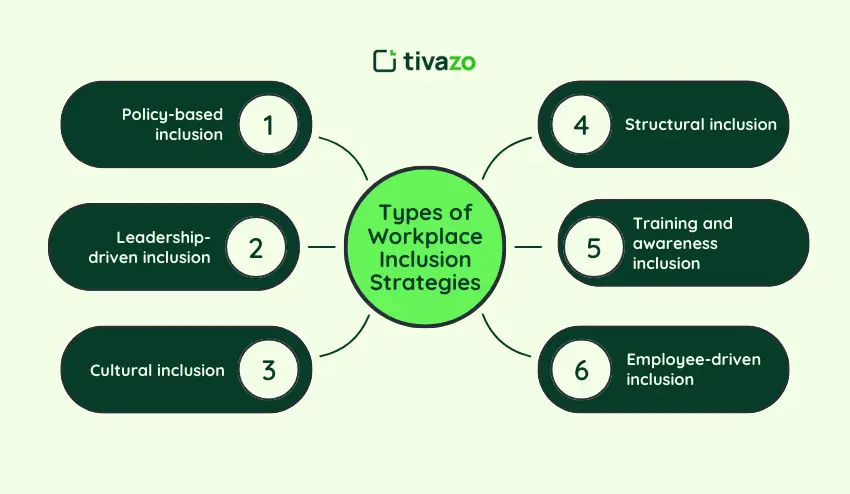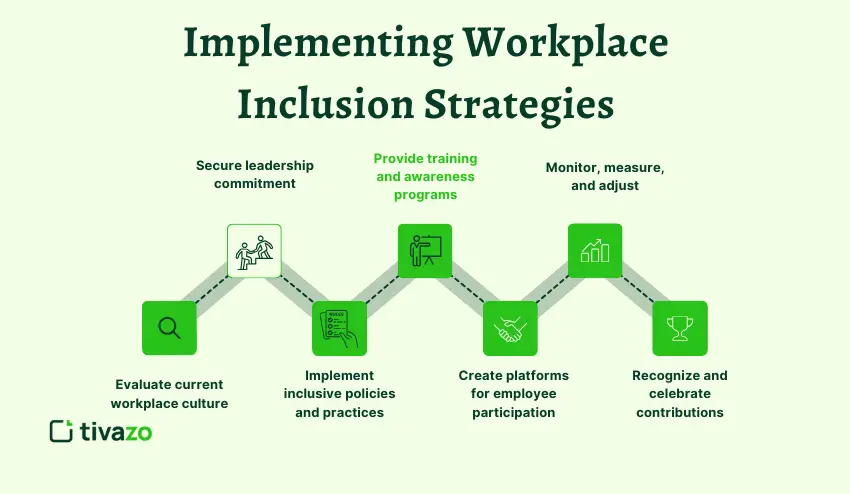Suppose you enter an office and all you hear are a few voices, the same people making decisions, and you see that some employees are left out. Innovation becomes sluggish, morale plummets, and talent does not remain long in such workplaces.
That is where workplace inclusion strategies come in. They contribute to the establishment of an environment in which each employee feels appreciated, respected, and supported, regardless of their background, position, and identity. Inclusion does not mean being nice. It has a direct effect on productivity, retention, and even the reputation of a company.
In this blog, we will dissect what an inclusive workplace means, why it is important, the benefits of an inclusive workplace, and the best workplace inclusion strategies you can employ to create a stronger and more collaborative workplace. You will also have practical examples and a practical action plan that you can begin to implement immediately.
What Is Workplace Inclusion?

Workplace inclusion involves creating an environment in which all employees feel respected, supported, and fully able to contribute regardless of their background, identity, or personal situation.
It’s not just about diversity hiring (hiring people from different groups). Inclusion is about ensuring that those diverse voices are heard, appreciated, and empowered. For instance, it’s one thing to hire people who come from diverse cultures; it’s another to give them equal opportunities to take on a leading role on a project, contribute ideas, and influence decisions.
Fundamental factors of inclusion in the workplace are:
- Equal opportunity – Where all employees have the same opportunity for promotion, training, and career development.
- Respectful culture – Where there is a commitment to acknowledge and welcome people with different perspectives at work.
- Psychological safety – Where everyone is able to speak up without being judged or penalized for their opinion.
- Active participation – Where all employees are encouraged to engage, give input, and contribute.
When an employer invests time and effort in workplace inclusion strategies, it creates a trusting and safe environment, and employees experience a heightened sense of belonging. Employees feel more motivated, innovation increases, and employers ultimately become known as fair and leading-edge employers.
Why Is Workplace Inclusion Important?
Workplace inclusion isn’t just an optional add-on: it’s a primary strategy to successfully grow your business. Companies should take a long-term approach to inclusion see a difference in both culture and performance.
Here’s why it matters:
- Increased employee engagement – Employees who feel included and valued are more engaged and loyal to the organization. This also helps in reducing employee turnover.
- Increased innovation – Teams with diverse skill sets and perspectives create better and more innovative solutions.
- Increased collaboration – Being inclusive reduces conflict and builds trust among employees with different backgrounds and experiences.
- Increased employer shared value/profitability/brand – Organizations known for being inclusive will attract and retain better talent
- Increased ability to meet legal and ethical standards – Although many regulators expect organizations to implement fair treatment of all employees and stakeholders, diversity and inclusion is more closely aligned with these expectations.
Overall, inclusion is about ensuring that everyone in your workplace can thrive. It is about balancing business objectives with human values; when your employees feel they belong, they are more productive, and their workplace performance will improve. These examples show you why proper workplace inclusion strategies should be implemented in a company.
Types of Workplace Inclusion Strategies
Workplace Inclusion strategies are the practical steps taken by organizations to ensure that all employees feel valued, respected, and empowered. Below are the primary types of inclusion strategies.

- Policy-based inclusion
- Written diversity and inclusion policies.
- Equal opportunity and anti-discrimination statements that establish a leadership tone.
- Leadership-driven inclusion
- Leaders who visibly and actively exhibit inclusive behaviors.
- Train managers to recognize their own unconscious bias to create fairness.
- Cultural inclusion
- Promoting different cultures with events, holidays, and awareness campaigns.
- Promoting the open dialogue about traditions, languages, and attitudes.
- Structural inclusion
- Adjustable work hours to accommodate different needs (e.g., parents, people with disabilities).
- Accessible work settings, equipment, and technology for all employees.
- Training and awareness inclusion
- Workshops on diversity, equity, and inclusion (DEI).
- Constant learning to decrease stereotypes and bias.
- Employee-driven inclusion
- Employee resource groups (ERGs) or networks for different communities.
- Providing employees with an opportunity to express feedback and influence the company culture.
Proven Workplace Inclusion Strategies to Implement
Talking about inclusion is one thing, and implementing it is another that needs regular work. The following are workplace inclusion strategies that can be implemented by companies:
- Start with leadership commitment
- Leaders are supposed to be the first to lead by example by being committed to promoting workplace inclusion strategies.
- Regularly communicate goals, progress, and expectations around inclusion.
- Implement inclusive hiring practices
- Use different job boards and networks to obtain candidates.
- Get biased language off job descriptions.
- Normalize the questions of the interviews.
- Foster open communication channels
- No fear of judgment when giving feedback to employees.
- Provide anonymous feedback systems to raise issues in a non-threatening manner.
- Promote mentorship and sponsorship programs
- Pair employees from underrepresented groups with mentors.
- Sponsors can lobby employees in leadership and promotion discussions.
- Celebrate diversity regularly
- Recognize cultural holidays, awareness days, and employee contributions.
- Organize company-wide activities in which the different viewpoints are put into the foreground.
- Offer continuous DEI training
- Hold workshops and learning seminars for the employees on a regular basis.
- Topics such as unconscious bias, inclusive language, and cultural awareness should be focused on in these workshops.
- Make space for introverts to shine
- Introverted employees are often given less preference compared to extroverted personalities.
- Adjust and provide time and space where introverted employees will feel comfortable sharing their ideas and opinions.
- Availability of anonymous suggestion boxes should be made so that quiet employees can share comfortably.
- Measure progress and adjust
- Track diversity metrics, and employee satisfaction surveys.
- Track and analyze progress using the information found in the metrics.
Workplace inclusion strategies provide a positive atmosphere where employees feel important, motivated and achieve higher results when properly implemented.
Benefits of Workplace Inclusion Strategies
Investing in workplace inclusion strategies brings tangible benefits to both employees and the organization. Employee engagement automatically goes up when employees feel noticed, listened to, and appreciated. Inclusive teams are more motivated, more loyal, and less likely to turn over, which enhances overall stability in the workforce.
Higher employee engagement:
After employees feel recognized, respected and valued, they will automatically be willing to give their best. Inclusive workplaces also aid in reducing the feeling of isolation since team members will feel that they are part of the team. This involvement leads to high levels of loyalty and low levels of turnover, which creates a more stable and devoted workforce.
Increased innovation and creativity:
Diversity encourages divergent thinking and that is the immediate origin of innovation. Teams can approach a problem in numerous ways by getting employees with diverse backgrounds, experiences, and skills to the table. This diversity of thought contributes to better problem solving, new solutions and better business performance.
Improved collaboration:
Inclusive environments build trust among team members. Employees are not afraid of judgment when sharing ideas, asking questions, and providing feedback. This mental security leads to greater cooperation, cuts down on misunderstandings, and enables projects to progress faster and better. This can hugely help in improving collboration skills in the workforce. Therefore, workplace inclusion strategies are vital to create an environment where collaboration between employees is at its peak.
Attracting and retaining top talent:
Organizations that have been recognized in a way that signals they truly value inclusion are more attractive to job seekers. The best employees are looking to join jobs that honor diversity and equity. Through effective inclusion approaches, organizations can attract high-quality talent and keep them longer, which will save the organization from unemployment and bonding and improve the stability of the team.
Better decision-making:
Inclusive teams also tap into a greater diversity of opinions and the decisions reached are more informed and balanced. With different perspectives, organizations can avoid blind spots, identify potential risks sooner, and make smarter and strategic decisions.
Enhanced company reputation:
Good dedication to inclusiveness makes a firm ethical, progressive and socially responsible. Such a positive image attracts customers, shareholders, and workers, and the image demonstrates that the organization values fairness, cooperation, and forward-thinking leadership.
Step-by-Step Guide to Implementing Workplace Inclusion Strategies

- Evaluate current workplace culture
- Conduct surveys, focus groups, and feedback in order to determine areas of engagement, communication, and representation deficiency to guide your workplace inclusion strategies.
- Examine the current laws and procedures with a view of understanding what should be improved.
- Secure leadership commitment
- Make sure that executives and managers are the first to set an example of being inclusive in their day-to-day interactions.
- Make inclusion goals a priority in leadership performance measurements.
- Implement inclusive policies and practices
- Equalize the hiring, promotion, and performance appraisal processes to minimize prejudice.
- Adopt versatile policies that can accommodate the demands of various individuals, such as cultural leave, access or working at home, keeping your workplace inclusion strategies flexible.
- Provide training and awareness programs
- Provide frequent DEI trainings on unconscious bias, inclusive language, and cultural sensitivity to strengthen workplace inclusion strategies at all levels.
- Encourage lifelong learning to enhance the spirit of inclusion at the board.
- Create platforms for employee participation
- Provide an opportunity to share ideas and feedback, such as town halls, anonymous suggestion boxes, or employee resource groups (ERGs).
- Allow introverts or other shy employees some safe space, such as less noise or other activities.
- Monitor, measure, and adjust
- Measure change by employee satisfaction, retention levels, employee engagement metrics and diversity percentages.
- Act on the information in a manner that enhances successful policies and strategies in the long run.
- Recognize and celebrate contributions
- Highlight inclusive behaviors and achievements across teams and the organization.
- Good behaviours are reinforced by awards to encourage positive behaviours amongst the workers and provide them with a feeling of belonging.
Conclusion
Implementing workplace inclusion strategies is essential for building a supportive, productive, and innovative work environment. Employees are respected and feel appreciated and their participation is more, teamwork is better and turnover is better. Not only is inclusion a matter of equity, but it also directly influences the business outcomes, employee satisfaction, and organizational reputation. By assessing your organization, culture, making sure you have supportive leadership, inclusive policies, training and making sure that everyone has room to contribute, your organization can create a truly inclusive workplace in which everyone among your employees will flourish.




